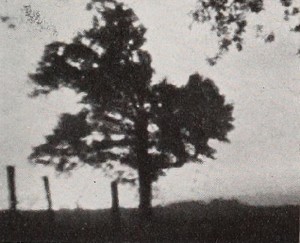
"Holiday with the Heavers is one of those rare films that display sincere artistic sensitivity that is manifestly not the product of technical skill nor the "slick" application of the rules of composition and film planning. It is a picture that promises that its maker — Dr. W. Lynwood Heaver — with more cinematic experience, might produce the finest type of amateur motion picture. Holiday with the Heavers is not a record of a family jaunt, as its title would imply. Rather, it is a scenic study of fall, enlivened by the presence of a three year old who investigates a park and explores the autumn leaves. Included in the film are beautiful and eerie shots of the late fall, effective silhouettes and charming closeups of the small actor." Movie Makers, Dec. 1943, 478.
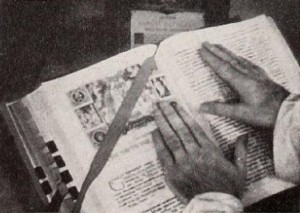
"The Reverend Edward J. Hayes, assisted by his brother, Paul J. Hayes, has made an impressive film record in The Holy Sacrifice of the Mass. All the details of the rite are shown simply and directly. The film was made at close range, and it affords the audience the celebrant's view of the altar. The excellence of the color in this Kodachrome work stresses the beauty of the vestments and of the religious articles. The understanding and devotion behind this effort are evident in the spiritual quality achieved." Movie Makers, Dec. 1943, 477.
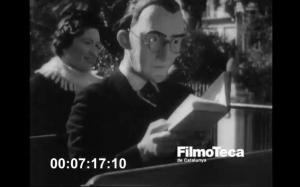
(Catalan): Història d'un home que es creu important, que està carregat de prejudicis i que duu una màscara per mostrar una aparença de persona seriosa i culta. Però quan se la treu, en la intimitat, deixa de fingir i és feliç. Un dia, al tramvia, coneix una noia que l'ajuda a desprendre's de la màscara que porta gairebé sempre posada.
Story of a man who acts as if he is important and who wears a mask to show the appearance of a serious and cultured person. But when he takes it out, in the intimacy of the home, he stops pretending and is able to relax and be happy. One day, on the tram, he meets a girl who helps him get rid of the mask by cutting loose of all of his prejudices. [Description from the Filmoteca de Catalunya catalog]
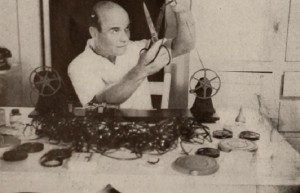
" 'Oh, would some power the giftie gie us, to see ourselves as others see us.' In a sophisticated, fast moving satire, Fred Evans has struck at some of the blights of amateur movie making and screening. Turning his opening guns on tyros who ignore the instruction book which accompanies a new camera, Mr. Evans proceeds in a light, witty manner to poke cine fun at those movie makers who insist on learning the hard way. The picture continues on its farcical path, pausing now to watch invitations being telephoned for a screening of an as yet on-existent film and again to sympathize at the scene of frantic last minute editing. Home Movies has as its climax, of course, the fiasco of the screening, which should not be "tipped off" by a verbal preview. Compact and restrained, this movie offers meaningful as well as light entertainment." Movie Makers, Dec. 1946, 471.
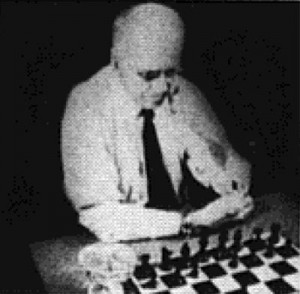
"The grace and beauty attained with advancing years is captured in this charming story, told with gentle wit and warm affection. Through the years, father has learned the wisdom of a slight deception to forestall a possible storm when he fails to follow orders, so is, instead, rewarded by his grateful wife. A memory-evoking addition to the family album of motion pictures" PSA Journal, Oct. 1963, 40.
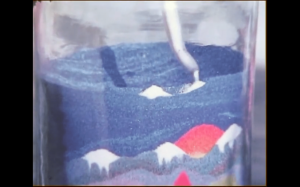
En este documental se muestra el proceso de elaboración de una curiosa pieza de artesanía: una botella de cristal rellena de arena de distintos colores, formando así motivos figurativos y geométricos.
This documentary shows the process of making a curious craft piece: a crystal bottle filled by sand of diverse colors that forms new figure and geometrical patterns.
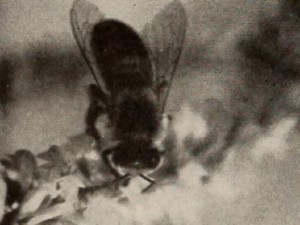
"If you have never thought much about the communal effort that produces your breakfast honey, you will find a whole new world of careful organization set forth in William W. Vincent, jr.'s movie. If you have read about this world, you will realize the very great accomplishment of the filmer of Honey Harvest, as you see his picturization of the regimented and incredibly organized bee communities. By means of amazing closeups, Mr. Vincent identifies the various workers, shows them at their hard tasks and lets us see the queen bee, the drones, the nectar scouts, the farmers, the nurses and all the complex bee classes. Nectar is sipped and collected; it is used or stored until, finally, man takes the residual product for his own use. A breakfast sequence of great compositional charm begins and ends this highly unusual record." Movie Makers, Dec. 1945, 494.

A man writes a note to inform his wife that he is leaving her. He then goes for a walk, seemingly with grave thoughts on his mind. He encounters sights which inspire him to return home, where he finds his wife in an alarming condition.

A man is angered when he returns home after work and finds that his wife is absent. He goes for a walk and imagines possible reasons for her absence. When he returns from his walk, he finds his wife in an alarming condition.
Total Pages: 299